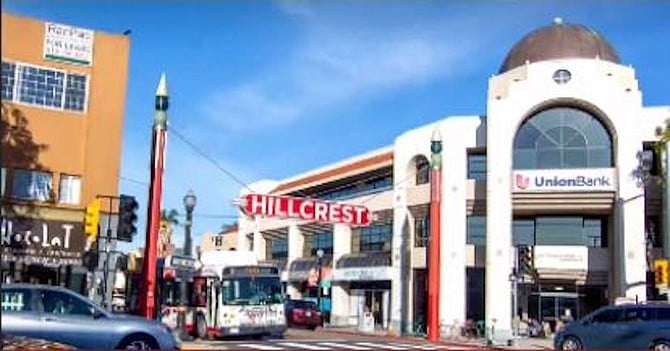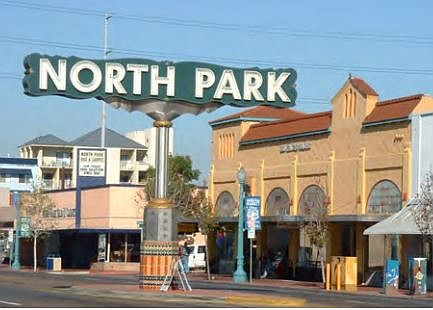 Facebook
Facebook
 X
X
 Instagram
Instagram
 TikTok
TikTok
 Youtube
Youtube

The battle continues over a plan to build 19,000 new homes in Hillcrest, which hasn't seen any boost in residential densities in more than three decades.
It has, however, seen such an increase in homelessness, a Starbucks had to close its doors earlier this year.
If the city passes the proposed Plan Hillcrest amendment, the 350-acre planning area will see density increases up to 218 units per acre in some areas where currently 109 are allowed, not to mention dozens of mid to very high, possibly even 30-story high, towers.
That, and 50,000 new residents; more than twice the population of the city of Coronado.
Anne Wilson, a Hillcrest local and affordable housing developer, spoke at the third public workshop on the plan last week, saying she supports a lot of the density increases, but not the overall plan.
"I'd like to know why we're giving away density without requiring affordable housing."
Wilson, who lives in a zone that would allow 73 units per acre, said she doesn't mind the density but questioned the height limits. "I think 20-30 stories for Hillcrest is ridiculous."
The plan adds two new community commercial base zones, where building height is based on floor ratio and the maximum density increases up to 218 and 290 dwelling units per acre. Ultimately, if the plan is adopted, these zones would be used in other parts of the city.

Shannon Mulderig, Plan Hillcrest project manager, said that with the maximum floor ratio of 8.0 the proposal will likely result in mid-rise buildings "around 15 stories max, with smaller unit sizes."
Building size in certain residential multiple unit and community commercial zones will be controlled by floor ratio, and other regulations, she said.
The city says the plan will allow San Diego to meet its climate goals by putting more homes near jobs, destinations, and high frequency transit.
The draft plan, which modifies the Uptown Community Plan adopted in 2016, impacts nearby communities like University Heights.
"Hillcrest is already the most congested community in San Diego's council District Three," said resident Kate Callen, who spoke against the plan.
North Park, also in District Three, allows 55-73 dwelling units per acre in its residential very high zones.
Supporters welcome the addition of more homes, as well as an LGBTQ+ cultural district — while opponents argue that community input won't matter under the by-right development plan. They say population growth projections are inflated and, in addition to homes not being required to be affordable, there's a lack of public spaces.
Bill Keller, who lives in Hillcrest, reminded city planners of the 14th Street promenade promised in the Downtown Community Plan's 2006 update.
"So far with 22 block faces we have about four developed after 17 years."
The urgency to create public spaces should drive housing development, he said. Others said some of the public promenades included in the proposal might be so wide they limit lot sizes on Washington Street and University Avenue.
The changes to the Hillcrest plan, if approved, will last through its 30-year life.
"So we need to figure out which projects should be discretionary and which by-right," said Tom Mulaney, with Uptown United. With by-right development, the process is streamlined and neighbors aren't notified.
An updated version of the plan which incorporates the public input will be released next year.


The battle continues over a plan to build 19,000 new homes in Hillcrest, which hasn't seen any boost in residential densities in more than three decades.
It has, however, seen such an increase in homelessness, a Starbucks had to close its doors earlier this year.
If the city passes the proposed Plan Hillcrest amendment, the 350-acre planning area will see density increases up to 218 units per acre in some areas where currently 109 are allowed, not to mention dozens of mid to very high, possibly even 30-story high, towers.
That, and 50,000 new residents; more than twice the population of the city of Coronado.
Anne Wilson, a Hillcrest local and affordable housing developer, spoke at the third public workshop on the plan last week, saying she supports a lot of the density increases, but not the overall plan.
"I'd like to know why we're giving away density without requiring affordable housing."
Wilson, who lives in a zone that would allow 73 units per acre, said she doesn't mind the density but questioned the height limits. "I think 20-30 stories for Hillcrest is ridiculous."
The plan adds two new community commercial base zones, where building height is based on floor ratio and the maximum density increases up to 218 and 290 dwelling units per acre. Ultimately, if the plan is adopted, these zones would be used in other parts of the city.

Shannon Mulderig, Plan Hillcrest project manager, said that with the maximum floor ratio of 8.0 the proposal will likely result in mid-rise buildings "around 15 stories max, with smaller unit sizes."
Building size in certain residential multiple unit and community commercial zones will be controlled by floor ratio, and other regulations, she said.
The city says the plan will allow San Diego to meet its climate goals by putting more homes near jobs, destinations, and high frequency transit.
The draft plan, which modifies the Uptown Community Plan adopted in 2016, impacts nearby communities like University Heights.
"Hillcrest is already the most congested community in San Diego's council District Three," said resident Kate Callen, who spoke against the plan.
North Park, also in District Three, allows 55-73 dwelling units per acre in its residential very high zones.
Supporters welcome the addition of more homes, as well as an LGBTQ+ cultural district — while opponents argue that community input won't matter under the by-right development plan. They say population growth projections are inflated and, in addition to homes not being required to be affordable, there's a lack of public spaces.
Bill Keller, who lives in Hillcrest, reminded city planners of the 14th Street promenade promised in the Downtown Community Plan's 2006 update.
"So far with 22 block faces we have about four developed after 17 years."
The urgency to create public spaces should drive housing development, he said. Others said some of the public promenades included in the proposal might be so wide they limit lot sizes on Washington Street and University Avenue.
The changes to the Hillcrest plan, if approved, will last through its 30-year life.
"So we need to figure out which projects should be discretionary and which by-right," said Tom Mulaney, with Uptown United. With by-right development, the process is streamlined and neighbors aren't notified.
An updated version of the plan which incorporates the public input will be released next year.
Comments